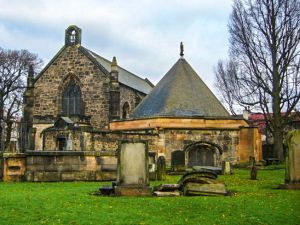
We do not know exactly when the chapel was built, but records show it was standing in 1477. What makes St Triduan'a Chapel unique is the design; it is a 2-storey hexagon, with a vaulted interior. The exterior is roughly 36 feet across.
The upper chamber was destroyed in 1560 during the religious turmoil of the Reformation, but the lower chamber survives intact, and is a remarkable example of late medieval architecture, with its hexagonal vaulted roof.
Who was St Triduana?
Tradition says that Triduana, or Trodline, was a Greek woman who accompanied St Rule to Fife when he brought the bones of St Andrew there in the 4th century. She lived near Forfar, in Angus, but her beauty attracted the unwanted attentions of the Pictish King Nectan. To escape from her unwanted suitor she tore out her own eyes and gave them to Nectan. she then retired to a cell at Restalrig, where she cured blind people who came to her.
After Triduana's death, her shrine continued to draw people with eye problems seeking a cure. Because the lower part of the shrine often flooded, it was assumed to be a holy well, which only enhanced the reputation of the saint!
The lower chamber was used by the Logan family of Restalrig as a burial vault. The entire structure was buried, then completely restored in 1906 by the 16th Earl of Moray. Part of that restoration was a new roof, which swept away the medieval stonework. The interior, however, is remarkably complete and consists of a central pillar with vaulted arches springing from it. On each side is set a three-light trefoil window with lovely tracery, though the window glass is not original.
The local parish church was also dedicated to Triduana (it is now dedicated to St Margaret), as are chapels at Loth in Sutherland, Ballachly in Caithness, and Papa Westray in Orkney.
The exterior can be viewed at any time, but to see the interior you have to make arrangements with St Margaret's Parish Church. See the Historic Scotland website for current details.
 We've 'tagged' this attraction information to help you find related historic attractions and learn more about major time periods mentioned.
We've 'tagged' this attraction information to help you find related historic attractions and learn more about major time periods mentioned.

